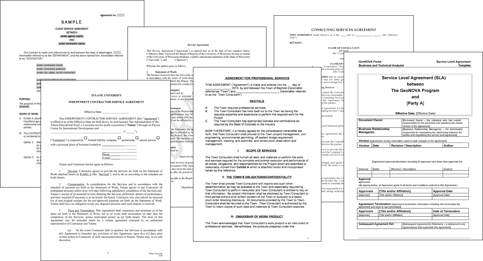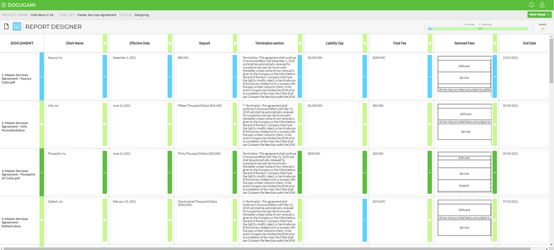Case Study: How Generative AI Can Transform Workforce Services
Company Embraces New Tools for Dynamic Work Structures
The composition of the workforce has changed in recent years. At many large companies today, up to half of the workforce may be ‘external’ workers, sourced from different companies and suppliers, for different reasons and specialties.
Workers can be hired as classic temporary contingent workers, freelancers or consultants, gig economy workers, or be contracted from specialty outsourced service providers.
Each of these relationships may be conducted by a variety of different agreement types, with complex, detailed terms prescribing the employment relationships.
Relying more on external workers means that Proposals, Master Service Agreements, Statements of Work, Addendums, Amendments, and other business agreements dictate much more of these relationships, creating a great deal of complexity that is captured in text documents.

Businesses must manage these agreements, to manage their business well. They must understand major pricing trends, potential cost savings, performance clauses, and exposure to risks by conducting thorough analyses of these staffing contracts. However, auditing terms and monitoring compliance with contracts is time-consuming, manual legal work. It requires extracting precise data points (for example milestone requirements, dates, amounts, quality metrics, fee tables, performance thresholds, SLAs, and legal requirements) that are buried in long-form documents of various formats and layouts.
To streamline the management of such a dynamic workforce, many companies turn to workforce services experts or staffing solution providers. These firms are experts in understanding and managing the myriad and complex contracts and other documents that characterize today's modern workforce.
Here are some of the advantages a prominent workforce management firm was looking for new technology to deliver, as they needed to scale up their work to respond to demand:
- SAVINGS = Shift 1,000 hours at $200/hour to customer-facing work by consultants, through document review automation
- GROWTH = 50% more brand-name clients, supported with the same expert team
- NET PROFIT = Faster evaluation and proposal, Same or higher price to client
Innovator Explores Alternatives to IDPs
One Docugami customer, in particular, has led this staffing evolution, as a global innovation leader helping companies of every type. They deployed Docugami to scale the reach of their team, and to meet the demand for their services (at their request, we are not disclosing their name, to preserve their competitive advantage).
The workforce procurement consultants at this firm have deep experience in auditing and analyzing staffing contracts. Over many years, they have developed a keen ability to read between the lines and find issues or opportunities within thousands of contracts on behalf of their firm and their clients.
It is time-consuming, tedious work for their experts to read and re-read every word of every contract, as contracts are initiated, or as existing contracts are reviewed for a new client. And, as workforce relationships evolve, the details matter.
They needed a way to scale out their expertise.
After trying a number of Intelligent Document Processing solutions to help with their workload, they had nearly given up. Existing solutions did an OK job searching for keywords but did not save them much time, due to the inherent document variations and complexity. They still had to go through the documents page by page to understand the context behind each term uncovered and did not trust the systems to deliver the nuances within the contracts.
Trying a Document Engineering / Generative AI Solution
After trying numerous IDP tools and finding them insufficient, the company tried Docugami.
They were immediately surprised and impressed. First, they were surprised by the flexibility of the product. It was not limited to prescribed fields for analysis. They could apply their expertise to discover ANYTHING in these documents that they felt could be valuable. All the information in every document was processed, so they could decide for themselves what was valuable.
And they could select new topics for analysis at any time, even months later, adding documents, and data points, without having to reprocess the documents.
Whatever data they asked for across hundreds of documents was automatically extracted and structured into a spreadsheet, for much easier visual scanning for problems and opportunities.
Docugami's generative AI also offered much easier, clearer, and more comprehensive reports and analyses for clients - in a fraction of the time previously devoted to this work.

This helped them with their core mission, to improve product and service delivery resources.
The consultants could quickly focus on the data with their clients, using their expertise to examine trends, insights, and problems to fix.
Contract analysis went from being a source of tedious process delays as they struggled to meet demand, to a growth opportunity with new value to impress their clients. They now review 10% of the documents to optimize the model for a new client, and get 100% of the data back.
At the same time, they could populate their own and their clients’ labor management systems with the data. Instead of spending precious staff time inputting each contract’s data manually, they could automate the process. Clients can now manage effectively and efficiently with their systems continuously updated to the ground truth that is in their agreements.

One more big advantage to adopting this new type of technology:
- SATISFACTION = Happy staffing consultants, impressed clients, data to drive the clients' transformation
Learn more about how generative AI can help YOUR business with YOUR document information.

